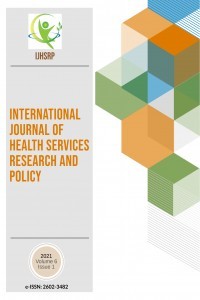CHALLENGES AND FACILITATORS TO THE SECONDARY USE OF ROUTINELY COLLECTED ORAL HEALTH DATA FROM MULTIPLE EUROPEAN COUNTRIES
CHALLENGES AND FACILITATORS TO THE SECONDARY USE OF ROUTINELY COLLECTED ORAL HEALTH DATA FROM MULTIPLE EUROPEAN COUNTRIES
policy, big data, secondary data analysis, health services research, qualitative,
___
- [1] Danciu, I., et al., "Secondary use of clinical data: the Vanderbilt approach," Journal of biomedical informatics, 52, 28-35, 2014.
- [2] Raghupathi, W., Raghupathi, V. "Big data analytics in healthcare: promise and potential" Health information science and systems,2(1), 3, 2014.
- [3] Safran, C., et al., "Toward a national framework for the secondary use of health data: an American Medical Informatics Association White Paper," Journal of the American Medical Informatics Association, 14(1), 1-9, 2007.
- [4] Auffray, C., et al., "Making sense of big data in health research: Towards an EU action plan," Genome Medicine, 8(1), 71, 2016. /doi: 10.1186/s13073-016-0323-y.
- [5] Border, P., "Big Data and Public health", POSTnote, UK Parliment, 2014: Available: http://researchbriefings.parliament.uk/ResearchBriefing/Summary/POST-PN-474
- [6] European Commission, "The Use of Big Data in Public Health Policy and Research" 2014.
- [7] European Commission, "eHealth action plan 2012-2020: innovative healthcare for the 21st century," Communication from the commission to the European parliament, the council, the European economic and social committee and the committee of the regions. Brussels, 2012.
- [8] Habl, C., Renner, A., Bobek, J., Laschkolnig, A. "Study on Big Data in Public Health, Telemedicine and Healthcare" European Commission, 2016.
- [9] Pastorino, R., et al., "Benefits and challenges of Big Data in healthcare: an overview of the European initiatives," European Journal of Public Health, 29, 23-27, 2019.
- [10] Big data for better outcomes., "About BD4BO." https://bd4bo.eu/index.php/about-the-programme/about-bd4bo/ (accessed 4.02.2020).
- [11] EHDEN. "European Health Data & Evidence Network." https://www.ehden.eu/ (accessed 04.02.2020.
- [12] Bourne, P.E, et al., "The NIH big data to knowledge (BD2K) initiative," Journal of the American Medical Informatics Association, 22(6), 1114-1114, 2015.
- [13] Leggett, H., et al., "Toward more patient-centered and prevention-oriented oral health care: the ADVOCATE project," JDR Clinical & Translational Research, 2(1),5-9, 2017.
- [14] Day, G.S., "Market driven strategy: process for creating value: with a new information." Free, 1999.
- [15] Basu, R., "Implementing quality: a practical guide to tools and techniques: enabling the power of operational excellence", Cengage Learning EMEA, 2004.
- [16] Van Panhuis, W.G., et al., "A systematic review of barriers to data sharing in public health," BMC public health, 14(1), 1-9, 2014.
- [17] Edelstein, M., Sane, J., "Overcoming Barriers to Data Sharing in Public Health: A Global Perspective," Chathamhouse.org. [Online]. Available: https://www.chathamhouse.org/publication/overcoming-barriers-data-sharing-public-health-global-perspective
- [18] Haux, C., et al., "A process model for acquiring international administrative routine data for health services research," GMS Medizinische Informatik, Biometrie Und Epidemiologie (online), 15(1), 2019.
- [19] Horton, J., "Nominal group technique: A method of decision‐making by committee," Anaesthesia, 35(8), 811-814, 1980.
- [20] Delbecq, A.L., Van de Ven, A.H., "A group process model for problem identification and program planning," The Journal of applied behavioral science, 7(4), 466-492, 1971.
- [21] Center for Disease Control and Prevention, "Gaining Consensus Among Stakeholders Through the Nominal Group Technique.," 7, U.S. Department of helath and Human Services, 2018. https://www.cdc.gov/HealthyYouth/evaluation/pdf/brief7.pdf
- [22] Mayring,P., "Qualitative content analysis," A companion to qualitative research, 1, 159-176, 2004.
- [23] Elo, S., Kyngäs, H., "The qualitative content analysis process.," Journal of Advanced Nursing, 62(1), 107-115, 2008.
- [24] Cornet, R., de Keizer, N., "Forty years of SNOMED: a literature review," in BMC medical informatics and decision making, 8(1), S2, 2008.
- [25] W. G. Van Panhuis., W.G., et al., "A systematic review of barriers to data sharing in public health," BMC public health, 14(1), 1144, 2014.
- [26] Patti DiGangi, R., "Dental Electronic Health Records: Meaningful and Useful," RDH, 2012.
- [27] Cantrill, J., et al., "The Delphi and nominal group techniques in health services research," International Journal of pharmacy practice, 4(2), 67-74, 1996.
- [28] Brown, S.R., "Q methodology and qualitative research," Qualitative health research, 6(4), 561-567, 1996.
- [29] Wengraf, T., Qualitative research interviewing: Biographic narrative and semi-structured methods. Sage, 2001.
- Yayın Aralığı: Yılda 3 Sayı
- Başlangıç: 2016
- Yayıncı: Rojan GÜMÜŞ
EXAMINATION OF COVID-19 FEAR IN TERMS OF ITS DEFINING CHARACTERISTICS
Sevim ÇİMKE, Dilek YILDIRIM GÜRKAN, Derya ESENKAYA
ATTITUDES OF PEDIATRIC NURSES AND TEACHERS TOWARDS CHILDREN’S RIGHTS AND THEIR PARENTAL ATTITUDES
Esra TURAL BÜYÜK, Emel ODABAŞOĞLU, Hatice UZŞEN, Merve KOYUN
Melda SOYSAL TOMRUK, Alp Tunca YAPICI, Nihal GELECEK, Orhan KALEMCİ
THE RELATIONSHIP BETWEEN HUMOR STYLE AND DEATH ANXIETY OF PALLIATIVE CARE PATIENTS
DOES THE FREQUENCY OF ACUTE CHOLECYSTITIS DECREASE DURING THE RAMADAN MONTH?
Murat SEYİT, Atakan YILMAZ, Sevda YILMAZ, Mert ÖZEN
Heather LEGGETT, Frank FOX, Karen VİNALL COLLİER, Julia CİSKAR, Evangelos ZORMPAS, Helen WHELTON, Gail DOUGLAS
Mustafa DURMUŞ, Halil ALKAN, Necmettin ÇİFTCİ
SEXUAL ORIENTATION MYTHS: DOES THEOLOGICAL EDUCATION AFFECT SEXUAL ORIENTATION MYTHS?
